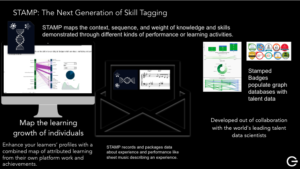Transforming the Workforce with ViiSA and PASS: A Technical Overview
Introduction
In today’s dynamic job market, individuals seek opportunities that align with their unique skills and experiences, while employers aim to find the perfect match for their organizational needs. Achieving this alignment has often been challenging due to the complexity and variability of talent data. However, with the advent of Verified Interoperable Individual Self Analytics (ViiSA) and Personnel Archetype Specification Standards (PASS), a new era of workforce optimization is on the horizon. In this technical overview, we will delve into the intricacies of ViiSA and PASS, exploring how these innovations are set to reshape the way individuals present their talents and how organizations match them to job descriptions.
Verified Individual Self Analytics (ViiSA)
ViiSA represents a breakthrough in talent data presentation and verification. It is built upon the foundation of LER Verifiable Presentation, a format that distills an individual’s complete profile from the Pythia-UTP (Universal Talent Passport) for specific purposes or objectives. ViiSA takes this concept further by filtering an individual’s stories and data visualizations from all 13 categories of the talent tree. The result is a dynamic web application page that serves as an interactive resume, enriched with data visualizations and verified credentials.
The Anatomy of a ViiSA
1. Interactive Resume
At its core, a ViiSA resembles an interactive resume. It offers a structured overview of an individual’s skills, experiences, and accomplishments. However, it goes beyond the traditional resume format by providing interactivity and real-time updates. Users can navigate through different sections and explore their talent data in a visually appealing manner.
2. Data Visualizations
One of the key features of ViiSA is the incorporation of data visualizations. These visual representations provide a clear snapshot of an individual’s proficiency in various skills and knowledge areas. From competency heatmaps to skill growth charts, data visualizations offer a holistic view of an individual’s talent journey.
3. Verified Credentials
ViiSA includes a section dedicated to verified credentials. These credentials are more than just badges or certificates; they contain comprehensive data about the skills and knowledge an individual has acquired. Verified credentials empower individuals to showcase their competencies with precision and credibility.
4. Multiple Data Formats
Flexibility is a hallmark of ViiSA. It presents data in various formats to cater to different needs. Users can access their ViiSA in HTML, Word Document, PDF, and LER-RS (LER-Readable Summary) formats, making it adaptable for a wide range of applications, from job applications to educational submissions.
The Power of ViiSA
Predictable Data Frameworks
ViiSA creates predictable frameworks of data that describe individuals in a standardized manner. Each ViiSA is carefully structured to ensure that vital talent data is presented consistently. This consistency is invaluable when matching individuals to job descriptions using PASS.
Personnel Archetype Specification Standards (PASS)
PASS, or Personnel Archetype Specification Standards, is a game-changing innovation in the realm of job descriptions. Unlike traditional job descriptions that are often text-heavy and subjective, PASS introduces machine-readable standards that define the specific requirements and expectations for a role.
Machine-Readable Job Descriptions
PASS transforms job descriptions into machine-readable formats. Each PASS defines the essential skills, knowledge areas, experience levels, and competencies required for a particular role. This standardization eliminates ambiguity and ensures that both individuals and organizations have a clear understanding of job requirements.
Matching Talent to Job Descriptions
The true power of PASS emerges when it is used in conjunction with ViiSA. ViiSA provides individuals with a detailed representation of their skills and knowledge, while PASS defines the criteria for job roles. By aligning the data from ViiSA with the requirements outlined in PASS, organizations can efficiently identify the most suitable candidates for their positions.
PASS Implementation
1. Creating PASS Profiles
Organizations can create PASS profiles for each job role within their organization. These profiles serve as the blueprint for the ideal candidate. PASS profiles include specific PASS codes that correspond to the skills, knowledge, and competencies required for the role.
2. Candidate Matching
Individuals can use their ViiSA to find job opportunities that match their talents. PASS codes embedded in job listings allow ViiSA to identify potential matches. This automated matching process streamlines the recruitment process and ensures that candidates meet the specified criteria.
3. Continuous Optimization
PASS profiles are not static; they can evolve as job roles change or new skills become relevant. Organizations can update PASS profiles to reflect the evolving demands of the job market, ensuring that they always attract the right talent.
Conclusion
In a world where talent data is abundant but often fragmented, ViiSA and PASS emerge as transformative solutions that bridge the gap between individuals and organizations. ViiSA empowers individuals to present their talents in a structured and compelling manner, while PASS provides organizations with standardized, machine-readable job descriptions.
The synergy between ViiSA and PASS holds the promise of more efficient talent matching, reduced recruitment costs, and improved workforce optimization. As these innovations gain traction, we can expect to witness a paradigm shift in how talent is discovered, assessed, and deployed, ultimately leading to more fulfilling career journeys for individuals and better-aligned organizations. The future of work is being shaped by ViiSA and PASS, and it is a future characterized by precision, clarity, and unparalleled talent optimization.





